Serving tea to guests transforms an ordinary visit into a memorable experience that speaks volumes about hospitality and care. Whether you’re hosting a casual afternoon catch-up or an elegant tea party, the way we present and serve tea sets the tone for meaningful conversations and lasting connections.
The art of tea service goes beyond simply brewing leaves in hot water. It’s about creating an atmosphere where guests feel welcomed and valued. From selecting the perfect tea blends to arranging delicate accompaniments, every detail contributes to the overall experience we create for our visitors.
We’ll guide you through the essential steps to elevate your tea service game, covering everything from proper brewing techniques to elegant presentation ideas. You’ll discover how simple touches can make your guests feel truly special while creating those cherished moments that keep people coming back to your table.
Essential Equipment for Serving Tea to Guests
Having the right equipment transforms your tea service from ordinary to extraordinary. We’ll explore the essential pieces that elevate your hosting game and ensure every guest feels pampered.
Tea Service Set
A complete tea service set forms the foundation of elegant tea presentation. We recommend investing in a matching teapot, cups, saucers, and sugar bowl that reflects your personal style. Porcelain sets offer timeless elegance while ceramic options provide durability for everyday use. The teapot should hold enough tea for your typical guest count, with 4-6 cup capacity being ideal for most gatherings.
Quality tea strainers prevent loose leaves from reaching your guests’ cups and maintain the tea’s smooth texture. We prefer fine mesh strainers that catch even the smallest particles. For loose leaf enthusiasts, infuser balls or basket strainers work wonderfully when brewing directly in the pot.
Tea cozies keep your brew at the perfect temperature throughout service. These fabric covers maintain warmth for up to 30 minutes longer than uncovered pots. We suggest choosing cozies that complement your table setting while providing practical insulation.
Serving Trays and Accessories
Sturdy serving trays organize your tea service and make transportation effortless. We favor trays with raised edges that prevent items from sliding during transport. Wooden trays add rustic charm while silver or stainless steel options create formal elegance. Size your tray to accommodate your complete service without overcrowding.
Napkin holders and small bowls for accompaniments keep your table organized and accessible. We place these strategically around the serving area so guests can easily reach what they need. Small spoons for stirring and serving belong in dedicated holders or arranged neatly on the tray.
Tea timers ensure perfect brewing every time. We use digital timers that alert us when different tea varieties reach optimal steeping times. This attention to detail shows guests you care about serving the finest cup possible.
Additional Tableware
Small plates for treats and snacks complete your tea service setup. We choose plates that coordinate with your tea set while providing adequate space for pastries, cookies, or finger foods. Dessert forks and cake servers help guests enjoy accompaniments with ease.
Cream pitchers and sugar bowls with accompanying spoons cater to different preferences. We fill these before guests arrive and place them within easy reach. Individual honey pots or jam dishes add special touches that guests remember long after they leave.
Water glasses complement the tea service and keep guests hydrated. We position these slightly away from the main tea setup to prevent confusion while maintaining easy access. Fresh flowers or simple centerpieces tie the entire presentation together without overwhelming the functional elements.
Ingredients and Tea Selection
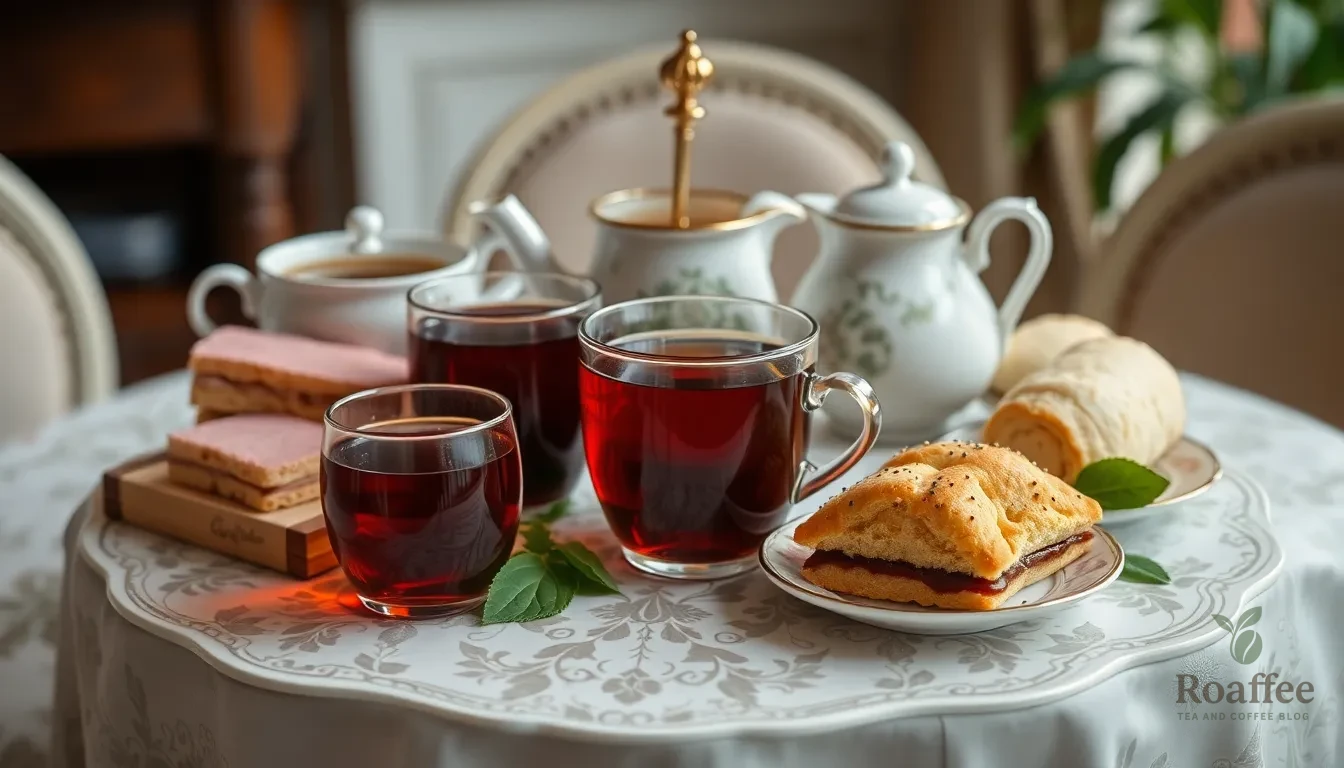
Now that we have our equipment ready, selecting the perfect tea and accompaniments becomes our next priority. The foundation of exceptional tea service lies in choosing quality ingredients that cater to diverse guest preferences.
Choosing the Right Tea Varieties
Black Tea stands as the most popular choice in the Western industry, offering a robust experience for guests who enjoy bold flavors. We recommend stocking English Breakfast and Earl Grey as essential varieties since these fully oxidized teas produce a strong, dark red brew with the highest caffeine content. Their rich character makes them perfect for guests who appreciate traditional tea experiences.
Green Tea provides an excellent alternative for health-conscious guests, delivering antioxidant benefits with lower caffeine content. This minimally processed option creates a pale yellow brew with a subtle buttery flavor that appeals to those seeking gentle refreshment. We find green tea particularly suitable for afternoon service when guests prefer lighter options.
Oolong Tea bridges the gap between green and black varieties, offering a woodsy taste with moderate caffeine levels. This partially oxidized tea satisfies guests who want complexity without overwhelming strength. We consider oolong an excellent choice for sophisticated palates seeking something unique.
Herbal Tea caters to caffeine-free preferences, though we must exercise caution due to potential allergies or side effects. These flower, fruit, and herb infusions provide diverse flavors that accommodate dietary restrictions and evening service.
Rooibos and White Tea round out our selection beautifully. Rooibos delivers a nutty, sweet profile without caffeine, originating from South Africa. White tea offers delicate subtlety that appeals to guests who appreciate refined flavors.
Accompaniments and Add-ins
We always provide classic additions including milk, lemon, honey, and sugar to accommodate individual preferences. Each tea type pairs differently with these accompaniments, so we arrange them attractively on small serving dishes for easy access.
Temperature considerations matter significantly when serving milk and cream. We keep dairy products properly chilled and provide small pitchers to maintain freshness throughout service. Lemon should be sliced fresh and arranged on a separate plate with small serving utensils.
Sugar options extend beyond granulated white sugar to include raw sugar, honey, and alternative sweeteners. We present these choices in elegant containers with appropriate serving spoons to maintain hygiene and visual appeal.
Sweet and Savory Pairings
Black teas pair exceptionally well with rich foods that complement their robust character. We serve smoked salmon sandwiches, buttery scones with clotted cream and jam, and hearty pastries that match the tea’s intensity without competing for attention.
Green and white teas require lighter companions that honor their delicate profiles. Fresh cucumber sandwiches, fruit tarts, and subtle pastries work beautifully to enhance rather than overpower these gentle brews. We avoid heavy or overly sweet options that might mask the tea’s natural characteristics.
Herbal teas offer versatility in pairing opportunities, working well with mildly sweet or spicy treats. Ginger cookies, nut-based desserts, and fruit-forward pastries create harmonious combinations that celebrate the herbal infusions’ unique qualities.
Light finger sandwiches, elegant scones, and carefully selected pastries complete our offering. We ensure that food portions remain manageable for comfortable consumption while maintaining the sophisticated atmosphere that exceptional tea service demands.
Preparation Steps
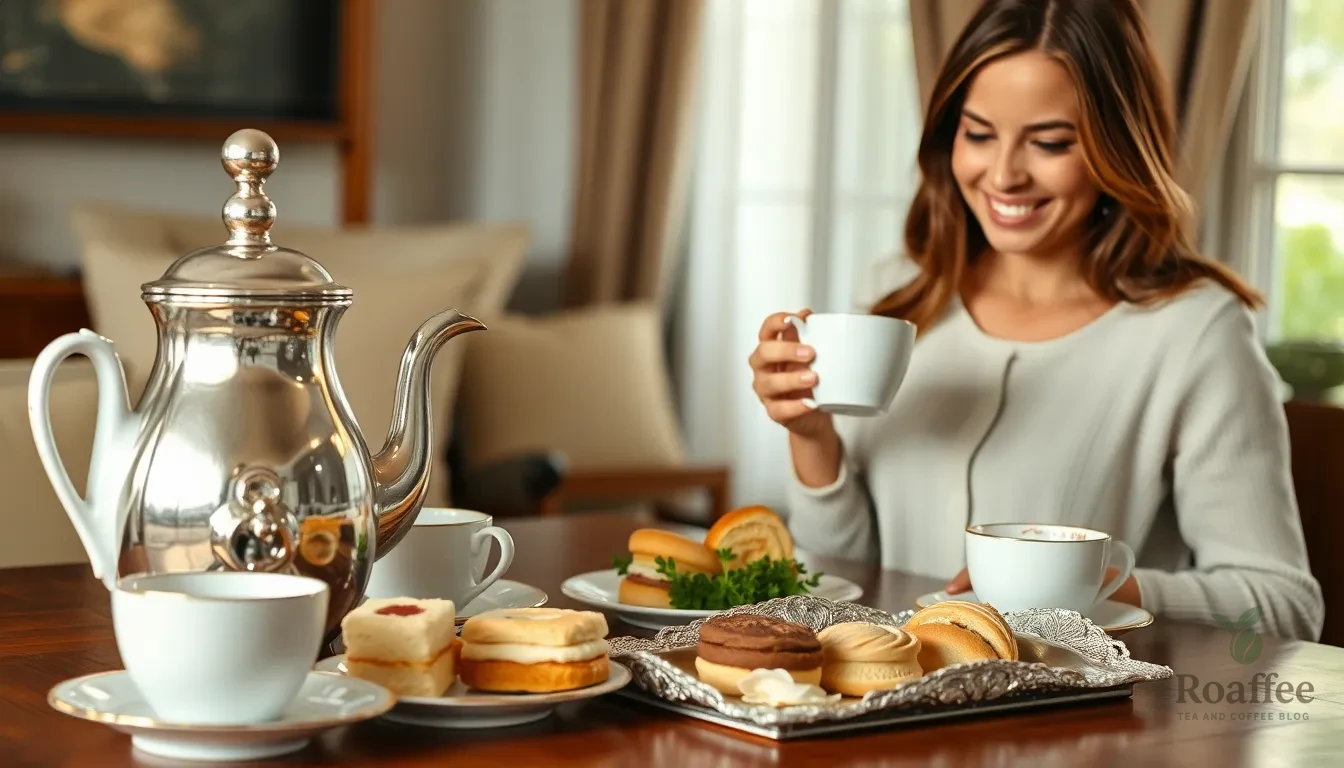
Success in tea service begins long before our guests arrive. We must establish a foundation of proper preparation to ensure every element flows seamlessly when serving time arrives.
Setting Up Your Tea Station
Creating a dedicated tea station transforms our service from ordinary to extraordinary. We organize a tray or designated area with our teapot positioned so its spout faces inward and handle outward for convenient pouring. Our cups and saucers stack neatly alongside teaspoons while the sugar basin with tongs sits within easy reach.
The hot milk jug requires positioning near the teapot for efficient service. We arrange all necessary utensils including our tea strainer in logical order to prevent fumbling during service. Comfortable seating and appropriate furniture create a cozy atmosphere that encourages relaxation and conversation.
Preparing the Tea Service
Timing becomes crucial when we prepare to serve our guests. We wait until all guests are seated before beginning the pouring process. Starting with the guest of honor on our left we move clockwise around the table with the host pouring last.
Each saucer receives our attention as we pick it up with the cup to avoid pouring into a cup sitting on the table. We fill each cup to approximately three quarters full before offering milk or sugar according to individual preferences. Gentle stirring prevents the spoon from clinking against the cup while maintaining the serene atmosphere.
Arranging Accompaniments
Small snacks and finger foods complement our tea service beautifully. We select sandwiches scones or pastries that enhance rather than overpower the tea experience. These accompaniments require thoughtful placement within easy reach of all guests.
Napkins receive proper placement in laps at the start of service while we maintain our tray or tea station throughout the event. Attentiveness to guest requests ensures everyone feels welcomed and cared for during the entire tea time experience.
Instructions for Proper Tea Service

Understanding the etiquette and techniques behind proper tea service transforms a simple gathering into a memorable experience for our guests. We demonstrate respect and friendship through thoughtful attention to traditional tea service practices.
Brewing the Perfect Cup
We begin by selecting a proper teapot for authentic flavor development. Loose leaf tea provides the most genuine taste experience when brewing for guests. Water temperature varies by tea type with black teas requiring boiling water while green and white teas need cooler temperatures between 160-180°F.
We bring the teapot directly to the table rather than pre-pouring cups in the kitchen. This approach allows guests to witness the brewing process and ensures optimal temperature when serving. The brewing time depends on our tea selection with black teas steeping 3-5 minutes and delicate teas requiring only 1-3 minutes.
Using a tea strainer prevents loose leaves from entering our guests’ cups when pouring. We keep the teapot covered throughout the brewing process to maintain consistent heat and prevent flavor loss.
Serving Tea to Your Guests
We pour tea for each guest individually as the host takes full responsibility for tea service. Starting with the guest of honor or moving clockwise from our left ensures proper etiquette while serving ourselves last. Each cup receives tea filling it three-quarters full to allow room for milk or sugar additions.
We present each cup on its saucer and never pour tea into cups left sitting on the table. This practice shows respect for our guests and maintains proper service standards. The teacup handle should face our guests for easy grasping.
We offer sugar milk or lemon but allow guests to add these accompaniments themselves after receiving their tea. Sugar and milk should never be added before pouring the tea as this affects the brewing process and flavor development.
| Tea Service Order | Action | Purpose |
|---|---|---|
| 1st | Serve guest of honor | Shows respect |
| 2nd | Move clockwise around table | Maintains order |
| 3rd | Host serves self last | Demonstrates hospitality |
Refilling and Maintaining Service
We keep the teapot covered with a cozy throughout the service to maintain optimal temperature. This practice ensures each cup tastes as fresh as the first pour. Monitoring our guests’ cups allows us to offer refills at appropriate moments without rushing the experience.
We replace tea bags or loose leaves when brewing multiple rounds to preserve flavor quality. Fresh tea leaves prevent bitter or weak subsequent servings. The timing for refills depends on guest preferences with some enjoying continuous service while others prefer to finish their current cup completely.
We maintain attentiveness to our guests’ needs without hovering or interrupting conversations. Polite offers for refills should come when cups are noticeably low but not completely empty. This balance ensures our guests feel cared for while maintaining the relaxed atmosphere essential to proper tea service.
Etiquette and Presentation Tips
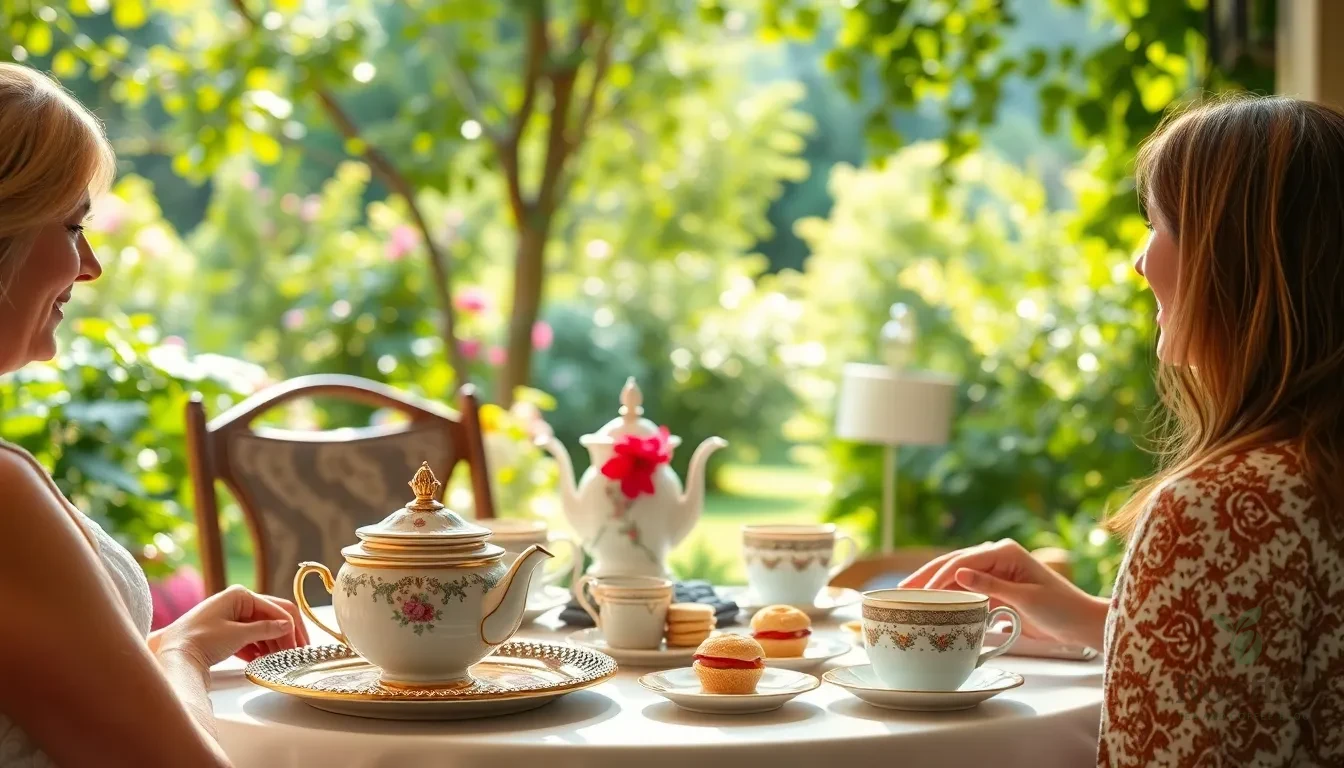
Serving tea to guests requires a thoughtful blend of proper etiquette and beautiful presentation to create an unforgettable experience. We can elevate our tea service by focusing on respectful manners, inviting atmosphere, and perfect timing.
Proper Tea Serving Manners
We should always serve tea personally as the host, pouring for our guests ourselves rather than relying on waitstaff. This personal touch demonstrates respect and friendship that makes guests feel truly welcomed. When pouring, we fill cups about three-quarters full to leave room for milk or sugar while preventing spills.
Our serving order follows traditional etiquette: we begin with the guest of honor seated to our left and proceed clockwise around the table. We serve ourselves last, ensuring every guest receives attention before we do. When seated, we keep the saucer on the table and lift only the teacup to drink. Standing requires us to hold the saucer in one hand and the cup in the other.
We coordinate our cups, spoons, and plates to match the occasion, improving our table setting with thoughtful details. After pouring, we sweeten tea according to each guest’s preferences, respecting individual tastes and dietary needs.
Creating an Inviting Atmosphere
We enhance our tea service by choosing outdoor settings when possible, such as gardens, balconies, or outdoor seating areas. These natural environments create a more relaxed and memorable atmosphere for our guests. We include complementary accompaniments like finger sandwiches, scones, or sweet treats to honor traditional tea customs and elevate the overall experience.
Our attention to decorative touches and overall setup provides a sense of luxury and comfort. We use a designated teapot on a tray with spoons, sugar bowl, and cups to maintain neat presentation while avoiding flavor contamination. Small details like matching servingware and thoughtful table arrangements transform ordinary tea time into an elegant affair.
Timing Your Service
We serve tea first before any other beverages or courses to symbolize our hospitality and attentiveness to guests. This traditional approach sets the tone for the entire gathering and demonstrates our commitment to proper service. We pour tea into cups away from the table, holding the saucer with the cup and serving one cup at a time directly to each guest.
Our service pace remains thoughtful and unhurried, allowing guests to savor the moment and interact comfortably. We maintain this relaxed timing throughout the experience, ensuring no one feels rushed while creating space for meaningful conversations to develop naturally.
Make-Ahead Tips
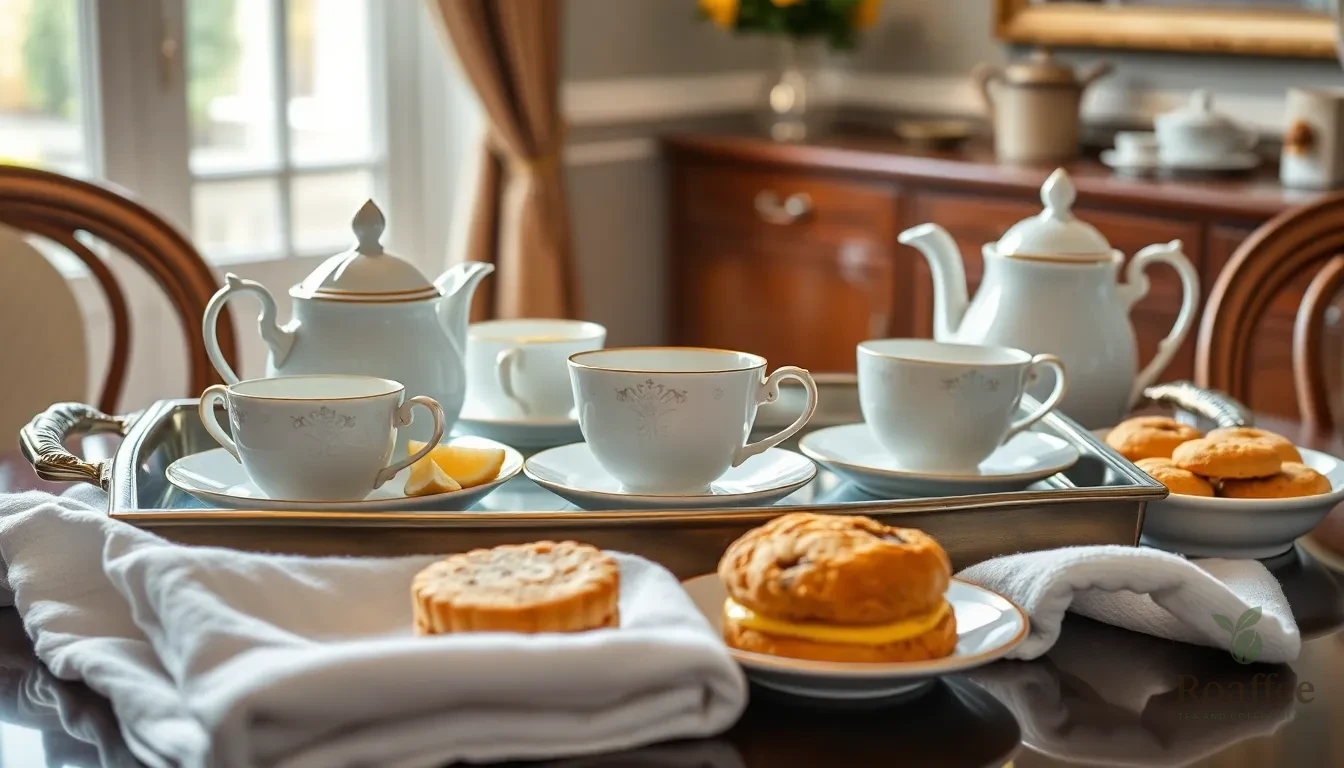
Planning ahead transforms tea service from stressful to seamless. We can prepare most components in advance while maintaining the fresh quality our guests deserve.
Preparing Components in Advance
We recommend setting up our tea station the night before to ensure smooth service. Place teacups, saucers, and serving utensils on designated trays to avoid last-minute scrambling. Our tea accompaniments like sugar bowls, cream pitchers, and lemon wedges can be arranged hours ahead of time.
Finger foods and sweet treats benefit from advance preparation as well. We should bake scones, prepare sandwich fillings, and arrange pastries on serving plates the morning of our tea service. Cover these items with clean kitchen towels to maintain freshness while keeping them easily accessible.
Setting our table with luncheon plates and minimal cutlery streamlines the serving process. We position water glasses above knives and arrange teacups diagonally to the right for elegant presentation. When serving champagne alongside tea, we place flutes at an angle nearby to complete our sophisticated setup.
Storage and Warming Instructions
Fresh tea requires careful temperature management to preserve optimal flavor. We use tea cozies or warming stands to maintain ideal serving temperature without overheating the brew. Reheating tea excessively compromises its delicate flavor profile and should be avoided.
Our sweet accompaniments need proper storage to maintain peak freshness. We store baked goods in airtight containers and arrange them attractively just before guests arrive. This approach ensures our treats look appetizing while preserving their texture and taste.
The teapot itself stays warm longer when we preheat it with hot water before adding our tea leaves. We empty this warming water just before brewing to ensure consistent temperature throughout the steeping process. This simple technique helps us serve perfectly warmed tea from the first cup to the last.
Troubleshooting Common Issues
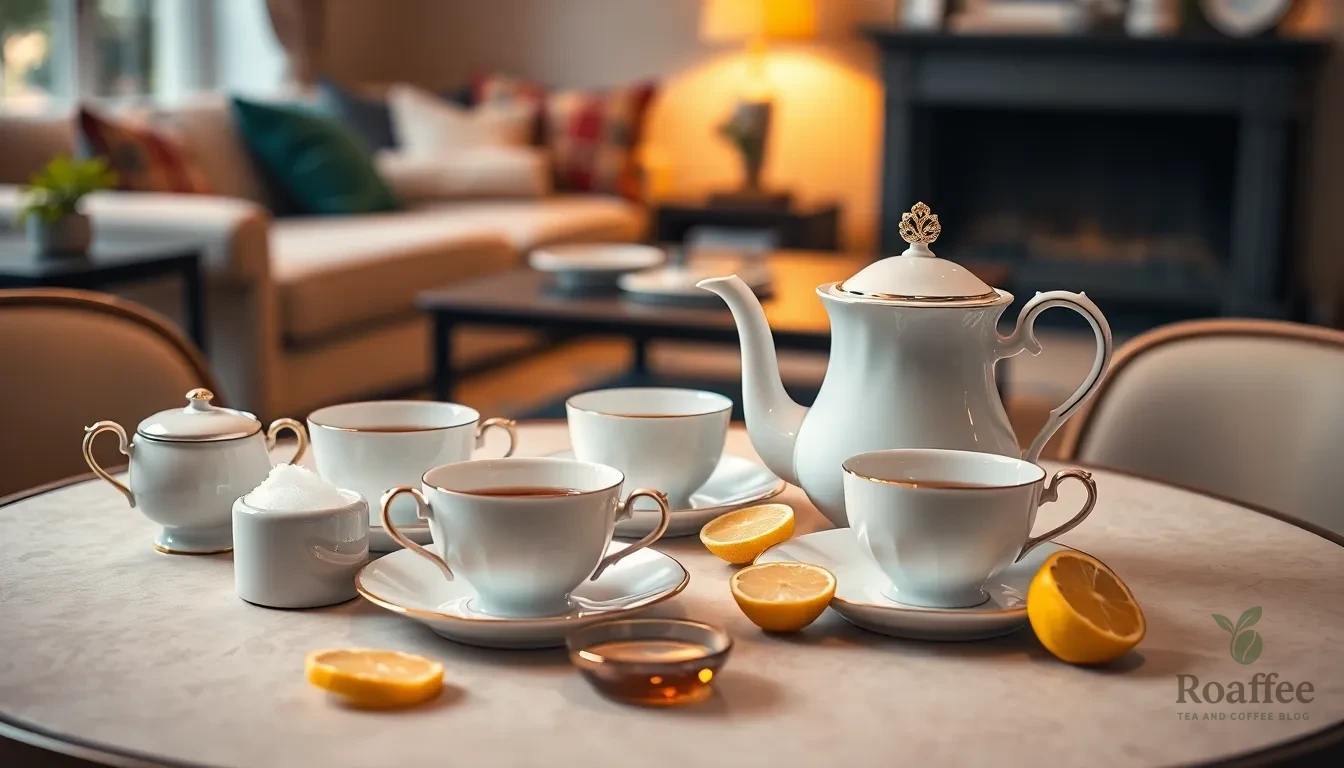
Even the most carefully planned tea service can encounter challenges that require quick thinking and graceful answers. We’ll address the most common issues that arise during tea service and provide practical strategies to ensure our guests remain comfortable and satisfied.
Temperature Control
Temperature control remains one of the most critical aspects of successful tea service. We should serve tea at an optimal temperature that’s hot enough to be enjoyable but not so scalding that it becomes uncomfortable to drink.
Our teapot warmer becomes essential equipment for maintaining consistent heat throughout the service. Place the warmer beneath the teapot to keep tea at the perfect drinking temperature for extended periods. This prevents the disappointment of lukewarm tea later in the service.
When guests find their tea too hot we can offer several immediate answers. Allow extra time for natural cooling while captivating in pleasant conversation. For black teas we can suggest adding a splash of milk to bring down the temperature quickly. Lemon serves a similar purpose and adds refreshing flavor notes that many guests appreciate.
Monitor the brewing temperature closely to prevent overheating from the start. Water that’s too hot can scald delicate teas like green and white varieties resulting in bitter flavors that no amount of cooling can remedy.
Handling Different Guest Preferences
Guest preferences vary significantly when it comes to tea service and we must be prepared to accommodate diverse tastes gracefully. Always ask each guest individually about their preferences for sweetener milk or lemon rather than making assumptions based on the tea variety being served.
We should offer sugar separately in small bowls with dedicated spoons allowing guests to adjust sweetness to their personal taste. This approach prevents over-sweetening and gives guests complete control over their tea experience.
Keep multiple accompaniment options readily available on our tea tray. Stock both regular sugar and honey for sweetening choices. Provide fresh lemon slices alongside milk to cater to different flavor preferences. Some guests prefer their tea completely plain while others enjoy multiple additions.
Address any guest dissatisfaction with immediate attention and care. Listen carefully to their exact concerns whether it’s about tea strength flavor or temperature. Take swift action to resolve issues by offering alternatives or preparing fresh tea that better meets their expectations.
Create a welcoming environment where guests feel comfortable expressing their preferences without embarrassment. We can proactively mention available options when serving to encourage guests to speak up about their needs. This attentiveness demonstrates our commitment to guest satisfaction and creates a more enjoyable experience for everyone at the table.
Conclusion
Serving tea to guests transforms a simple beverage into an experience that brings people together. We’ve covered everything from selecting the right equipment and teas to mastering proper etiquette and presentation techniques.
The key to exceptional tea service lies in thoughtful preparation and genuine attention to your guests’ needs. By implementing our make-ahead tips and troubleshooting strategies you’ll create a relaxed atmosphere where meaningful conversations naturally flow.
Remember that perfect tea service isn’t about rigid rules—it’s about making your guests feel welcomed and valued. With these techniques in your repertoire you’re ready to host memorable tea experiences that’ll leave lasting impressions on everyone who joins you.
Frequently Asked Questions
What equipment do I need for a proper tea service?
You’ll need a complete tea service set including teapot, cups, saucers, and spoons. Essential items include quality tea strainers, a tea warmer to maintain temperature, and decorative centerpieces. Consider adding sugar bowls, milk jugs, and small plates for accompaniments. Attention to detail with proper equipment ensures a memorable and professional tea service experience.
What types of tea should I offer guests?
Offer a variety including black teas (Earl Grey, English Breakfast), green teas, oolong, herbal teas (chamomile, peppermint), rooibos, and white teas. This selection caters to different preferences and dietary needs. Consider your guests’ tastes and the time of day when choosing teas to serve.
What accompaniments should I serve with tea?
Classic additions include milk, lemon slices, honey, and sugar presented attractively in small bowls or containers. Pair rich foods like scones and pastries with black teas, lighter options like cucumber sandwiches with green and white teas, and versatile treats like cookies with herbal teas.
How do I set up a tea station properly?
Create a dedicated area with your teapot as the centerpiece, surrounded by cups, saucers, and accompaniments. Arrange items logically for easy access and efficient service. Include small spoons, napkins, and plates for food. A well-organized station creates a cozy atmosphere that encourages relaxation and conversation.
What’s the proper etiquette for serving tea?
Serve the guest of honor first, then continue clockwise around the table. Pour tea individually for each guest, filling cups about three-quarters full. Use loose leaf tea when possible and maintain optimal water temperatures. Monitor guests’ cups for refills while maintaining a relaxed, attentive atmosphere throughout the service.
How can I prepare for tea service in advance?
Set up your tea station beforehand and arrange accompaniments in advance. Prepare finger foods and sweet treats ahead of time, storing them properly to maintain freshness. Preheat your teapot and use proper storage for baked goods. This preparation allows you to focus on your guests during service.
What should I do if the tea is too hot or cold?
Use a teapot warmer to maintain optimal temperature throughout service. If tea is too hot, allow it to cool slightly before serving or add a small amount of cool water. If it becomes too cold, reheat gently or brew fresh tea. Always taste-test before serving to ensure the perfect temperature.
How do I accommodate different guest preferences?
Offer various sweeteners including honey, sugar, and artificial alternatives. Provide both milk and lemon options, and ask guests about their preferences. Keep different tea varieties available and be attentive to individual needs. Open communication about preferences ensures every guest feels valued and comfortable.









![The Healing Herbal Teas Beginners' Guide [All-in-1]: Everything on How](https://m.media-amazon.com/images/I/51zNV97pyPL._SL500_.jpg)










